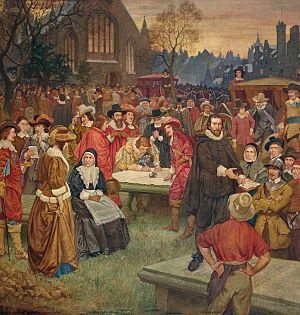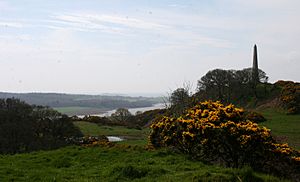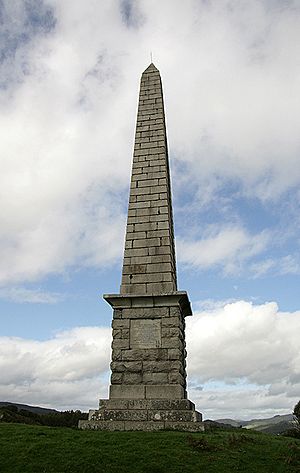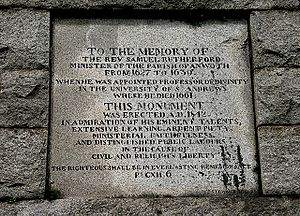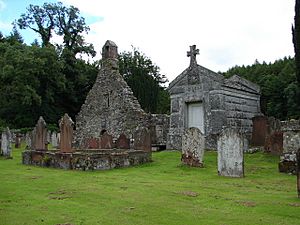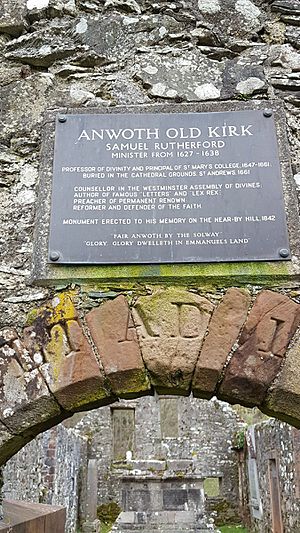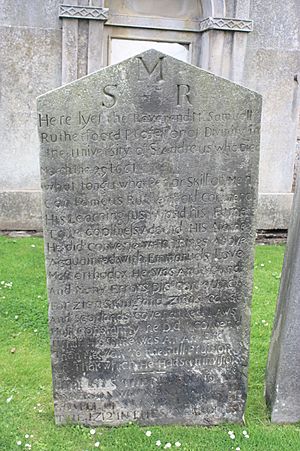Samuel Rutherford facts for kids
Quick facts for kids
Samuel Rutherford
|
|
|---|---|
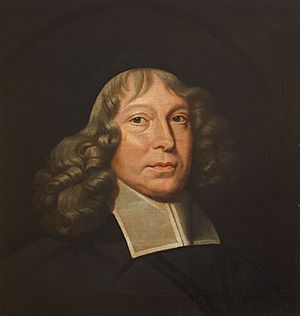 |
|
| Born | c. 1600 Nisbet, Roxburghshire, Scotland
|
| Died | 29 March 1661 (aged 60–61) |
| Alma mater | University of Edinburgh (MA) |
Samuel Rutherford (born around 1600 – died March 29, 1661) was an important Scottish Presbyterian minister and religious thinker. He was also one of the Scottish representatives at the Westminster Assembly, a group that helped shape the beliefs of the Presbyterian Church.
Contents
Life of Samuel Rutherford
Samuel Rutherford was born in a place called Nisbet in Scotland, around the year 1600. His family might have been farmers or millers. He had a brother who was a school teacher and another who was a soldier in the Dutch army.
Early Education and Ministry
Rutherford went to Jedburgh Grammar School and then the University of Edinburgh. He earned his Master of Arts degree in 1621. In 1623, he became a teacher at the University of Edinburgh.
In 1627, he became a minister at Anwoth Old Church in Scotland. People said he was very dedicated, always praying, preaching, visiting sick people, teaching, writing, and studying.
Challenges and Exile
In 1636, Rutherford faced trouble because of his religious writings. He was accused of not following the rules of the Church of England. He was told to stop being a minister and had to move to Aberdeen.
Even though he was far from home, he used this time to write many of his famous letters. These letters were very inspiring to people.
Return and Important Roles
In 1638, Rutherford returned to Anwoth. He became a professor of religious studies at the University of St Andrews in 1639. He also served as a minister there.
He was a strong supporter of the Covenanters, a group who wanted to protect the Presbyterian Church in Scotland. In 1643, he was chosen to be one of Scotland's representatives at the Westminster Assembly in London. This assembly worked to set up new rules for the church. Rutherford stayed in London for four years, preaching to important leaders.
Later Life and Legacy
In 1647, Rutherford became the leader of St Mary's College at St Andrews University. He was offered other important teaching jobs in Holland and Edinburgh, but he chose to stay in St Andrews. He was also elected as the university's leader several times.
After the king returned to power in 1660, Rutherford faced problems. His book, Lex Rex, which talked about how the law should be above the king, was ordered to be burned. He was accused of treason, but he died on March 29, 1661, before he could be put on trial. He is buried in the churchyard of St Andrews Cathedral.
Rutherford's Lasting Influence
Samuel Rutherford is a very important figure in the history of the Church of Scotland. His ideas and writings had a big impact during his life and continue to inspire people today.
Famous Letters and Writings
Many editions of his letters have been published. They are known for their deep thoughts and beautiful language. A famous preacher, Charles Spurgeon, said Rutherford's letters were almost like divine inspiration.
One of his most famous sayings was: "Glory shines in Immanuel's Land." This phrase inspired a well-known hymn.
Rutherford's Monument
There is a tall stone monument, like a tower, built in 1842 to honor Rutherford. It stands on a hilltop overlooking Anwoth, where he used to be a minister.
Family Life
Samuel Rutherford was married twice. His first wife, Euphame Hamilton, died in 1630. He later married Jean M'Math in 1640. They had several children, but most of them died before him.
Key Writings
Rutherford wrote many books and letters. His writings covered different topics, from religious devotion to ideas about government.
Lex Rex and Government Ideas
His political book, Lex, Rex, or The Law and the Prince (1644), made him famous as a thinker. In this book, he argued that the law should be more powerful than the king. He believed in limited government, meaning the king's power should have limits.
After the king returned to power, this book was burned in public. It was even banned at the University of Oxford.
Church and State Views
Rutherford believed the church and the government should be separate but also work together. He thought the king should not control the church but should help support the true religion.
He also strongly believed that the Presbyterian way of organizing the church was the one commanded in the Bible. He debated this idea with other religious leaders from New England.
List of Works
- Exercitationes pro Divina Gratia (1636)
- A Peaceable and Temperate Plea for Paul's Presbytery in Scotland (1642)
- A Sermon before the House of Commons (1644)
- The Due Right of Presbyteries (1644)
- Lex Rex, or The Law and the Prince (1644)
- A Sermon before the House of Lords (1645)
- The Trial and Triumph of Faith (1645)
- The Divine Right Of Church Government and Excommunication (1646)
- Christ Dying and Drawing Sinners to Himself (1647)
- A Survey of the Spiritual Antichrist (1648)
- A Free Disputation against Pretended Liberty of Conscience (1649)
- The Last and Heavenly Speech and Glorious Departure of John, Viscount Kenmure (1649)
- Disputatio Scholastica de Divina Providentia (1649)
- The Covenant of Life Opened (1655)
- A Survey of 'The Survey of that Sum of Church Discipline' penned by Mr. Thomas Hooker (1658)
- Influences of the Life of Grace (1659)
- Joshua Redivivus, or Mr Rutherford's Letters (1664)
- Examen Arminianismi (1668)
- A Testimony left by Mr. S. Rutherford to the Work of Reformation (uncertain date)
- A Treatise on Prayer (1713)
- The Cruel Watchman, The Door of Salvation Opened (1735)
- Twelve Communion Sermons (1876)
- Quaint Sermons (1885)
- Rutherford’s Catechism: Containing the Sum of Christian Religion. (1886)
- A discussing of some arguments against Cannons and ceremonies in God’s worship (1998)
See also
- Covenanters
- Andrew Bonar
- George Gillespie
- Alexander Henderson
- Robert Baillie
- Rutherford Institute


